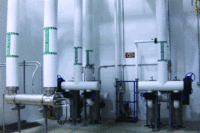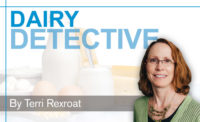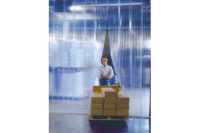
Murray Bain, vice president marketing, Stanpac Inc.
Elisabeth Comere, director, environment and government affairs, Tetra Pak North America
Ron Cotterman, executive director of sustainability, Sealed Air Corp.
Paul Dean, vice president, commercial North American packaging, Scholle Packaging
Jim Dwyer, CEO/president, RB Dwyer Group
Roman Forowycz, group president/chief marketing officer, Clear Lam Packaging
Hella Gourven, marketing manager, Crown Food Packaging North America
Sveinar Kildal, director, corporate environment, Elopak
James D. Taylor, business development manager, sustainability, Printpack Inc.
Dairy Foods: How do you define sustainable packaging?
Ron Cotterman, Sealed Air Corp.: For packaging to be sustainable, it must meet the demands for value and performance while minimizing environmental impact. For dairy food packaging, our priorities are to produce products that extend distribution and offer convenience, protection and efficiency while reducing waste, conserving energy and optimizing raw materials when possible.
From an environmental perspective, many consider the ideal packaging product to weigh almost nothing and have the capacity to be recycled. But when you take a closer look at the role packaging plays in reducing waste, you realize you must quantify environmental impacts of packaging and the contents of the packaging throughout the entire supply chain. Understanding the impact throughout the supply chain is an important first step toward improving overall environmental sustainability.

Hella Gourven, Crown Food Packaging North America: Crown approaches sustainability in three ways: social, environmental and economic. In other words, it’s the materials we use, the products we design and the way we do business.
Murray Bain, Stanpac: We define sustainable packaging as a product that has as little impact on the environment as possible. The package however needs to meet the criteria of the customer and also meet the need of the consumer.
Paul Dean, Scholle Packaging: A sustainable package reduces stress on the environment through less materials usage, and increases efficiencies in storage, shipping and end-use logistics.
Jim Dwyer, RB Dwyer Group: Customers say they want an “environmentally friendly” product and it is sometimes challenging to understand what that means. One of our goals is to educate the customer as to what films are available. We offer PLA film, a compostable film made from plants, a renewable resource and PETG, a recyclable film. In some cases, we suggest that the film be down gauged, which reduces the amount of film used. The use of lighter film is a quick and easy way to make a sustainable change and reduce the amount of packaging used.
Dairy Foods: Some dairy processors use seals and tamper-evidence in their product packaging, but this can mean extra material that adds weight, and it needs to be recycled. How can a processor balance sustainability practices with its food-safety needs?
Cotterman: We are in the process of introducing a new reclosable shredded cheese package with a peel-off seal that allows for immediate tamper detection and eliminates the need for a zipper and secondary seal. In some cases, this technology has resulted in a materials reduction of 2-4 inches.
Sveinar Kildal, Elopak: Food safety and sustainability are both critical. The balance comes from continuous improvement in reducing the amount of raw materials. This is true even of renewable resources like the paperboard in our carton, which we have made significantly lighter over the years.
Elisabeth Comere, Tetra Pak North America: Aseptic packaging is based on the principle of ensuring that both food and packaging materials are free of harmful bacteria at the moment the food is packaged. The result is a packaged food product that can be described as “commercially sterile,” which means that it can be preserved safely at ambient temperature from six months to one year or more.
For dairy products specifically, the aseptic technology and ultra high temperature (UHT) processing makes milk products shelf stable, which brings benefits associated with not having to rely on a chilled distribution chain. The UHT process purifies the milk at a high temperature for a short time, killing all bacteria without harming the quality of the nutrients. The purified milk is then sealed in sterile cartons, which have six layers of protection to keep impurities, light and oxygen out.
Gourven: One of the key benefits of metal packaging is that product is filled, retorted and shipped in a single container, without the need to add materials later in the process. This includes secondary packaging, which thanks to metal’s inherent strength, is often unnecessary. Since the material is rigid and robust, the can is more resistant to damage during shipping.
Consumer safety and long shelf life, in fact, are arguably the metal can’s most notable and time-tested attributes. Cans are hermetically sealed, so microbes, oxygen, light and other agents cannot infiltrate, contaminate or degrade the contents. By choosing metal, dairy processors don’t have to pick just sustainability or food safety - they get both in one convenient package.
Bain: Food safety is a given and can’t be compromised. The goal with tamper-evident solutions is to find one that has as little impact as possible.
Dean: A key part of sustainability for processors is the protection of their customers and the proper delivery and dispensing of their product. Our products for the dairy market feature tamper-evident seals and caps.
Dairy Foods: Please share an example of how your company helped a processor convert to sustainable packaging.
Roman Forowycz, Clear Lam Packaging: We worked closely with Stonyfield Farm over a two-year period to develop and commercialize new plastic yogurt cups made from renewable plant-based raw materials. This breakthrough technology replaced petroleum-based polystyrene plastics (PS #6) cups.
In addition, Clear Lam invested significant resources into R&D and commercialized packaging technologies that minimize the impact on the environment. This is part of our Project EarthClear initiative. Three key areas of technology drive this. The first, renewable raw materials, includes rigid packaging and films made from bio-based materials instead of oil. The second focuses on recycled plastic and paper content for flexible and rigid packaging. The third, lightweighting, is designed to reduce the carbon footprint of packaging through less plastic while maintaining strength, quality and integrity.
Comere: Bright Dairy is China’s largest provider of fresh milk, yogurt and cheese products. When Bright Dairy decided in 2008 that it needed a program to ensure long-term sustainable growth, the company turned to Tetra Pak. Since then, Tetra Pak has helped Bright Dairy implement a sustainable operational cost reduction (OCR) program that has achieved operational cost reductions of up to 10.9%.
The scope of the OCR-CI program focused on the pre-processing and filling units and included a range of improvement actions. These actions included water flush control for pasteurization, more accurate raw milk reception, optimized milk recycling procedures, air push devices for UHT processing and overfilling reduction, leading to a reduction of product waste of more than 24%.
Taylor: Our standup pouch offers a major producer of personal-care products the following sustainable benefits when compared to the existing paperboard carton: source reduction, fewer greenhouse gas emissions, less water consumption and fossil fuel reduction.
The manufacturer saw a 72% reduction in total weight of the secondary packaging, from 1,529 tons per year to 434 tons. GHG emissions decreased 77% and water consumption was reduced 94% for the manufacture of base materials and conversion to finished secondary package. There was a 27% reduction in fossil fuel consumption for the manufacture of base materials and conversion to finished secondary package.
Based on the individual packaging weight, unit volume and industry recycling rates, the comparative amount of our material to landfill after recycling is 395 tons per year versus 611 tons per year of CRB paperboard. This equates to a 35% reduction in solid waste to landfill.
Bain: We have converted a number of customers from plastic ice cream packaging to paper. We use paperboard that is FSC-certified. The Forestry Stewardship Council follows best practices in forest management.
Dean: We pioneered a new low-acid aseptic filling system. Sustainability is enhanced through efficiencies gained by longer production runs, reduced chemical consumption and less energy use with ambient distribution of the filled package.
Cotterman: Sealed Air packaging specialists have assisted dairy customers using Cryovac branded products in the development of more sustainable packaging by converting their materials to high-performing, lower-gauge films for cheese products ranging from 8 ounces to 5 pounds. These reduced-gauge films allow for a reduction in materials and resources while still offering consistent product protection.
Dairy Foods: Has your company produced life-cycle analysis or greenhouse gas emission reports regarding packaging?
Dean: We have completed an LCA study for its 3-liter bag-in-box wine market. The study showed bag-in-box packaging to have fewer impacts on the environment than other packaging.
Cotterman: As part of our SmartLife initiative, we help our customers assess the energy, carbon and waste implications for packaging and the products the packaging protects throughout the entire supply chain. We also demonstrate the wider cost, environmental and social impacts of food and product waste so customers can prioritize and implement more sustainable packaging decisions.
We’ve found that the carbon footprint of packaging and the energy to produce packaging is far less than the carbon footprint associated with the production of the food product the packaging protects. The contents of the package are critical when assessing carbon footprint and conducting life cycle analysis.
For example, by the time the food has reached the consumer, a significant amount of natural resources have been expended to grow, harvest, process, transport and store the product. Food that spoils in the consumer’s pantry or refrigerator wastes not only the product at hand, but all the natural resources that went into delivering the good to the home. Furthermore, food that ends up in a landfill can actually contribute to greenhouse gas emissions.
Kildal: Studies show that carbon dioxide emissions from gabletop carton production are less than one-third the level produced by plastic and glass bottles, perhaps as little as one-tenth as much. Over the past three years, Elopak has reduced its own carbon footprint, company-wide, by 14%
Dairy Foods: Dairy foods are sold in multiple channels, including grocery, c-store, vending, foodservice and institutional. Do your sustainable packaging solutions vary according to channel of distribution?
Taylor: The club store channel seems especially in need of sustainable packaging alternatives. Multipacks, in particular, are often over-packaged in heavy, expensive corrugated or paperboard. To the extent that Printpack can offer flexible packaging alternatives to traditional club store multipack formats, we can bring significant value to our customers that distribute products through these channels.
Bain: Glass refillable bottles for milk and dairy products are gaining popularity in grocery stores and home delivery in some parts of the country remains strong. There is a benefit to using a container over and over again. And, with home delivery, one vehicle delivering milk and dairy products saves each family a trip to the grocery store, which reduces emissions greatly.
Comere: Our packaging solutions do vary according to the channel of distribution. Our portfolio is broad and our cartons adapt according to the distribution channel used. The light weight and shape of the cartons drive efficient distribution in the dairy supply chain, which leads to a low environmental impact. Aseptic packages make the product shelf-stable, meaning they don’t need to be refrigerated for transportation and storage, helping to reduce greenhouse gas in transport.
Dairy Foods: Packaging can jam equipment resulting in waste and spoilage. How do your products (or your training) help a processor reduce waste on the production line?
Comere: In the last year, we have further improved the environmental efficiency of our filling equipment by minimizing the energy and water consumption, as well as the operational waste.
With these new generation filling machines, dairy processors will cut the waste generated by 30%. Specifically, our A3 filling line is the first in the world to receive an Environmental Product Declaration certification. This machine consumes 11% less energy, produces 30% less waste, uses 70% less water and 80% less cleaning agents.
Taylor: We offer field technical service resources. We are available to troubleshoot when there are productivity issues and will often proactively provide line audits to help customers to reduce waste through the set up and run processes.
Gourven: Metal packaging is also a cost-effective choice of format thanks to its fast filling speeds. It is efficient to manufacture due to material and design simplicity. In most can-making operations, the metal starts as a flat sheet and then is manipulated into the familiar canister shape.
Bain: Our ice cream filler is installed by our technical service professionals who focus on training the operators on the principals of running and maintaining the equipment so that it will run efficiently and with low waste.
Dean: We develop and build filling equipment designed specifically for our bag-in-box packaging. We hold training events for our customers’ production line and plant engineering personnel prior to installing a filler.
What’s Next in Dairy Packaging?
A 2009 report from PMMI found these expectations over the next two to three years:
• The shape of milk containers in greener bottles
• Reduced package weight
• Greater concentration on making a safer product
• Case-less secondary packaging
• Flexible packaging with re-closeable closures
• Appeal to higher-value niche markets
• Packaging and labeling more attractive
• More packaging innovation
Source: Dairy Industry Market Research Study, PMMI. PMMI is a trade association of companies that manufacture packaging, processing and related converting machinery.
Extras
Clear Lam Packaging www.clearlam.com
Crown Food Packaging North America www.crowncork.com
Elopak www.elopak.com
Printpack Inc. www. printpack.com
RB Dwyer Group www.therbdwyergroup.com
Scholle Packaging www.scholle.com
Stanpac Inc. www.stanpacnet.com
Tetra Pak North America www.tetrapak.com
Sealed Air Corp. www.cryovac.com


